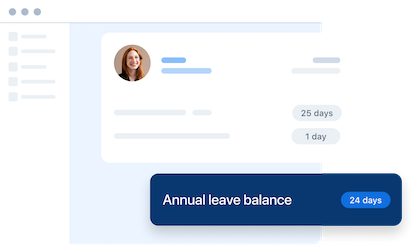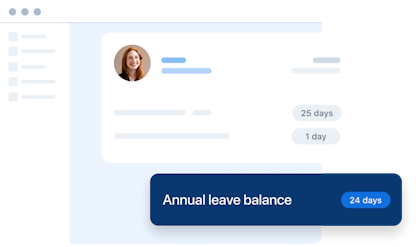- Blog
- |People management
- >Annual leave and absences
- >Calculating annual leave
How to calculate annual leave in the UK


We all love a holiday, don't we? Whether it be to a fancy seaside resort, a relaxing city break or a staycation, there's nothing better than being able to turn work mode off and take some well-earned rest.
However, once it's all over, all we can often think about is where and when our next one will be.
It can be even more difficult if you're a UK business owner. With a constant barrage of questions from sun-starved employees asking how much annual leave they have left to take or whether company policy allows for holiday carry over, it can all get a little tiresome.
Thankfully though, help is at hand by way of this guide, including an annual leave calculator for UK businesses.
In this short piece, we run through how to calculate annual leave entitlement and explain everything you need to know about employee rights in the UK.
Scroll down to access our annual leave calculator.
Your annual leave entitlement
How much holiday you receive is normally set out in your employment contract.
Most UK workers with fixed-hour contracts are entitled to a minimum of 5.6 weeks' annual leave per year, capped at 28 days paid unless a company offers an additional amount. It is important to note that bank and public holidays CAN be included in the 5.6 weeks.
If you're a UK worker with a non-fixed, zero or casual hour contact, then you are entitled to a percentage of annual leave for every hour you work.
Annual leave calculator
Basic annual leave calculation
For a basic calculation of UK leave allowance, multiply the number of days you work on average each week by 5.6.
For example, if you work a five day week, you would be entitled to 28 days' annual leave a year.
5 days x 5.6 weeks = 28 days
How to calculate annual leave for part-time workers
If you're a part-time worker in the UK, the same calculation applies.
This means that regardless of how many days you work, you will still be entitled to 5.6 weeks, multiplied by the number of days you work per week.
For example, if you work just three days a week, you would multiply this number by 5.6.
3 days x 5.6 weeks = 16.8 days
Annual leave calculator
How many days a week does your employee work?
Minimum entitlement:
28 days
It is worth remembering that even if your employee works six or even seven days per week, the maximum statutory entitlement per year remains capped at 28 days of statutory paid leave.
How to calculate annual leave for casual workers and zero-hour contracts
If you're someone who does not have a set number of working hours each week, your annual leave calculation will be done slightly differently.
For each hour you work, you will accrue a minimum percentage as annual leave. This percentage is based on how many weeks of the year you are available to work.
For example, if you can potentially work 52 weeks of the year, you would accrue 12.07% annual leave for every hour you work.
The calculation for this method is as follows.
52 weeks available to work minus 5.6 weeks of annual leave. This equals 46.4 weeks worked.
5.6 weeks / 46.4 weeks x 100 = 12.07%
If you have a different arrangement – e.g. term-time shifts – the calculation would be different.
For example, if you work 41 weeks of the year minus 5.6 weeks annual leave, then this would be equal to 35.4 weeks worked.
5.6 weeks / 35.4 weeks x 100 = 15.82%
When should annual leave be paid in the UK?
There are two instances when you must be paid holiday pay:
when you take annual leave
when you leave employment
Regular payments for accrued leave to employees, including those on zero-hour contracts, are not allowed. This is called 'rolled-up holiday pay' and is no longer accepted by HMRC and the Advisory Conciliation and Arbitration Service (ACAS).
How much annual leave can a UK employee carry over?
What does the law say?
You must take all of the EU statutory leave (four weeks) during the leave year. If you don't, it will be lost.
The 1.6 weeks (or eight days if you work full-time) that the UK adds to this statutory leave may be carried over if agreed with your employer. However, this is not an automatic right.
Exceptions to the law
If you have holiday carry over due to being on maternity, paternity or adoption leave, you can carry the entire amount over.
However, if the carry over is due to sickness, you can carry up to 20 days over.
Your employer can decide to offer more than the statutory leave, and, in this case, more leave can be carried over. This should be stated on your employment contract and in any accompanying employee handbooks.
I have a small business, should I allow annual leave carry over?
If you're a business owner, you will need to decide whether you want to allow unused holiday days to be carried over.
Many employers worry about the costs associated with allowing carry over and the impact that it will have on the business.
It's important to remember that statutory holiday entitlement is there for a reason and employees should be encouraged to take time off.
With an estimated 40% of UK employees using their full holiday entitlement, it may be a nice option to offer your employees; however, the choice is obviously up to you.
Managing annual leave and other leaves on PayFit
PayFit is much, much more than just a simple payroll solution.
As well as being an HMRC-accredited payroll provider, the PayFit app also acts as a holiday management solution for UK businesses. Employees' holiday entitlement is automatically calculated within the app and all payslips are subsequently updated in real-time to reflect changes in annual leave.
Employees can also request leaves and access their annual leave balance within their employee portal.
Finally, through the app's calendar view, all team members can see when one of their colleagues is on annual leave. This can help reduce the likelihood of employees booking time off at the same time.

PayFit's disclaimer
The information contained in this document is purely informative. It is not a substitute for legal advice from a legal professional.
PayFit does not guarantee the accuracy or completeness of this information and therefore cannot be held liable for any damages arising from your reading or use of this information. Remember to check the date of the last update.

UK Expenses Management - A Guide For Employers

Overtime Pay Rates & Laws in the UK

The 2024 UK National Living Wage - An Employer’s Guide

The Cost Of Recruitment In The UK - What You Might Not Know

UK National Insurance Changes for January 2024


